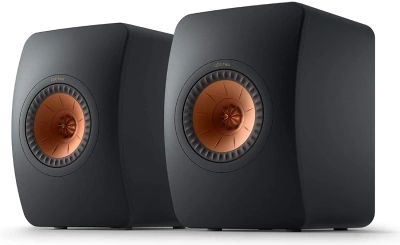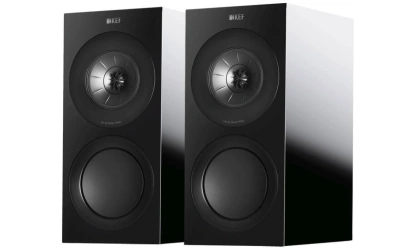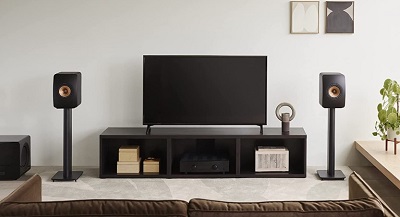Founded by a BBC engineer in the early 1960s, KEF has been a leading name in the audio technology world for decades. Their high-end speakers, subwoofers, and other audio equipment brings professional-level performance into any space, giving them the versatility to excel in home theaters, listening rooms, or anywhere else you want audiophile-approved KEF sound.
Comparing the KEF LS50 Meta vs R3, you’ll see both are paired loudspeakers designed for medium to large rooms in homes. While the KEF R3 can play louder and sounds better doing it (>>> Find on Amazon), the sleek design and smaller size of the LS50 Meta makes them easier to setup, and will make them the better fit for some buyers. Let’s take a closer look at where they differ in this side by side comparison.
KEF LS50 Meta vs R3 Side by Side:
| KEF LS50 Meta | KEF R3 | |
|---|---|---|
 |  |
|
| Maximum output | 106dB | 110dB |
| Sensitivity | 85dB | 87dB |
| Frequency range | 47Hz – 45kHz | 52Hz – 28kHz |
| Dimensions | 12”H X 7.9”W X 12.2”D (each speaker) | 16.6”H X 7.9”W X 13.2”D (each speaker) |
| Price | Find on Amazon | Find on Amazon |
Design and Size
The KEF R3 is a stand-mounted 3-way loudspeaker with dual drivers. While that’s good news from a sound perspective, it adds bulk and weight to the speaker, and most users install them on a dedicated stand. This can be an issue in rooms with space constraints, where you’ll likely prefer smaller bookshelf speakers. Their look is best described as functional. The exterior casing is well-designed, with precision-cut grilles and 3 finish options including black, walnut, and white gloss, but they’re not the most stylish-looking speakers on the market.
The KEF LS50 has an eye-catching, modern design that you’ll be proud to display in your home. With four finish options (Carbon Black, Mineral White, Titanium Gray, and Royal Blue), they’re a pair of speakers that have looks along with audio power. They are also smaller and lighter than the KEF R3, so while you can buy a dedicated stand for them, they’re compact enough to function as bookshelf speakers or be setup on an entertainment center.
Better design: KEF LS50 Meta
Volume Output
The KEF LS50 has an impressive volume capability for its size. Its maximum output of 106dB is plenty high enough for most spaces and situations. That said, the KEF R3 has even more output power in comparison, and will be the better choice for large entertainment spaces, especially since you can still hear all the details of the sound and get the same broad frequency response regardless of the volume setting of the speakers.
Higher volume output: KEF R3
Sound Quality
This is another category where we’re impressed with both of these sets of speakers, but one’s just a smidge better. The two-way design, wide frequency response, and high amplifier power of the KEF LS50 produce a detailed and accurate sound, with a clear mid-range and deep, full bass end from the woofer, sparing many the need to purchase a subwoofer. Its Uni-Q driver array uses MAT to reduce coloration and distortion, with design features like the precision-engineered DMC baffle and cross-bracing in the cabinet to reduce vibrations.
The KEF R3 is a three-way speaker, with a separate bass woofer, mid-range amplifier, and a 1-inch aluminum tweeter for high frequencies. This further enhances the sonic detail compared to the KEF LS50 and means it can handle more demanding audio tracks. Along with this it has a wide frequency response (52Hz-28kHz) and is driven by up to 180 watts of amplifier power. You’ll especially notice the difference in the low frequency end. Its R Series woofer uses a unique geometry for punchier, more responsive, and more impactful bass, equal in power and depth to what you’ll get from a typical stand alone subwoofer.
Better sound quality: KEF R3
Value
The price of the KEF R3 speakers reflects their impressive performance. It’s rare to find them at a cost of less than $2,000. That’s not an unreasonable cost for audio equipment with this level of sophistication and performance, but it’s likely more than many users planned to spend for a set of bookshelf speakers.
The KEF LS50, in comparison, typically sell for a price of around $1,600, and you can purchase the speakers for less when they’re on sale. That means you can conceivably buy an external sub woofer as well as the bookshelf speakers for the same amount of money, and makes them the better overall value compared to the KEF R3.
Better value: KEF LS50 Meta
KEF LS50 Meta

The KEF LS50 is a precise and powerful pair of speakers with excellent sonic detail. It uses a 12th-generation Uni-Q Metamaterial Absorption Technology driver, an innovative design that absorbs 99% of unwanted noise for a pure, distortion-free signal and more natural, realistic output compared to the majority of bookshelf speakers.
The injection-molded compound used inside the housing adds to the sonic clarity, with Constrained Layer Damping (CLD) that controls internal vibrations for minimal coloration. The off-set port, meanwhile, reduces coloring from turbulence and resonance, further improving the depth and detail of the audio output.
Maybe the most impressive thing about the KEF LS50 Meta, though, is that all these features come packed into a very compact and stylish set of loudspeakers. These speakers are designed to fit in any listening room, both in terms of size and style, with four sophisticated color options to choose from and a sleek, modern look to fit any decor.
Pros
- Reduced distortion for a more natural sound
- Wide frequency range with solid bass response
- Good output power for their size
- Excellent sound detail for music or home theater use
- Compact and stylish design
Cons
- High price for the speaker size and design
KEF R3

Each KEF R3 speaker has two drivers inside: a 6.5-inch bass driver and a 5-inch midrange driver with an aluminum dome tweeter array. Like the KEF LS50, it uses a Uni-Q driver array to improve the sonic imaging. This design means powerful and precise sound for music, movie soundtracks, or whatever else you want to listen to.
The KEF R3 are powerful speakers ideal for listeners who want to fill a room with sound. They have a higher maximum output than the KEF LS50 above. This doesn’t just give them more volume potential, it also means the sound stays crisp and distortion-free as it gets louder. That’s why the KEF R3 are a great option for home theater spaces, making it possible to get a truly immersive sound experience.
Now, bear in mind these are not small bookshelf speakers. KEF’s R3 loudspeakers are on the heavier side, and they perform best when placed on a dedicated stand. What the cabinet lacks in aesthetics, though, it makes up for in quality. The interior bracing effectively dampens vibrations that can affect the sound, ensuring you hear music, dialogue, and sound effects the way they were intended.
Pros
- Powerful sound output
- Exceptional bass response
- Well-braced to reduce vibrations
- Pure, natural sound with minimal distortion
- Consistently high build quality
Cons
- Bulky and heavy
Customer Impressions
In a review by real-world users, the KEF LS50 gets as close to a perfect score as you’re likely to find in a search for bookshelf loudspeakers. It’s especially highly-rated for the impressive caliber of its construction, as well as sheerness and overall audio output.
By comparison, the reviews of the KEF R3 are a bit lower, though still consistently close to five stars. The main difference here is value for the money,, and that’s the only place buyers express doubts about the R3. On factors like audio signal accuracy and authenticity, the R3 gets near-perfect reviews and ratings.
The Verdict: KEF LS50 Meta vs R3
Either the KEF LS50 or R3 can be an exceptional choice to bring professional-level audio to a home entertainment space. Based purely on sonic output, the KEF R3 is the better choice (>>> Check on Amazon). However, the more compact LS50 Meta still out-performs the majority of bookshelf speakers on the market, is easier to setup, and is a great way to get top sound when you have limited space. We hope this review has helped you decide which one is your ideal speaker!